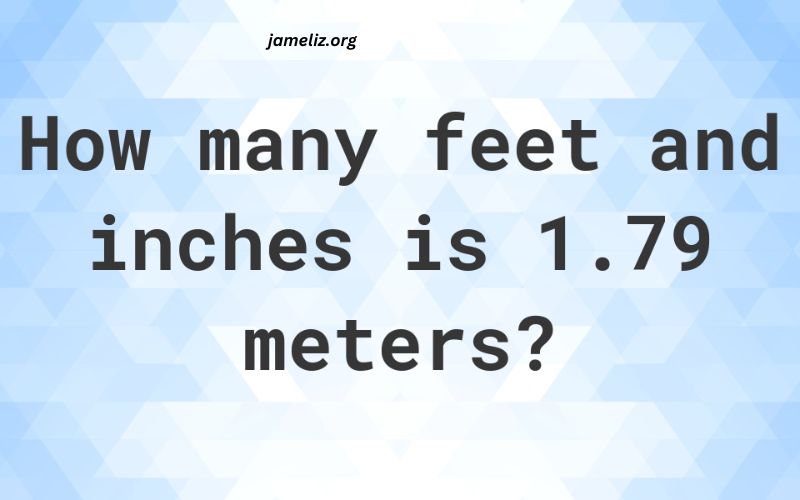The Metric and Imperial Systems
Before diving into the conversion, it’s important to understand the measurement systems involved: the metric system and the imperial system. The metric system, used widely around the world, includes units such as meters, centimeters, and kilometers. The imperial system, primarily used in the United States, includes units such as inches, feet, and miles.
Meters and feet are units of length in these systems. One meter is the base unit of length in the metric system, while one foot is a common unit of length in the imperial system. Converting between these units requires a specific conversion factor.
Conversion Factor: Meters to Feet
The conversion factor between meters and feet is straightforward: 1 meter=3.28084 feet1meter=3.28084feet
This means that for every meter, there are approximately 3.28084 feet. To convert from meters to feet, you multiply the number of meters by this conversion factor.
Calculating the Conversion
To convert 1.79 meters to feet, you simply apply the conversion factor: 1.79 meters×3.28084 feet/meter≈5.8727 feet1.79meters×3.28084feet/meter≈5.8727feet
Thus, 1.79 meters is approximately 5.8727 feet. For practical purposes, this is often rounded to two decimal places, giving us 5.87 feet.
Practical Applications of the Conversion
- Height Measurement: One of the most common uses of converting meters to feet is for measuring height. In many countries, height is measured in meters and centimeters. However, in the United States and other places that use the imperial system, height is measured in feet and inches. For someone who is 1.79 meters tall, knowing that this converts to approximately 5 feet 10 inches (since 0.87 of a foot is roughly 10 inches) is useful for contexts such as medical forms, personal records, and social introductions.
- Travel and Navigation: Conversions between meters and feet are essential in travel, especially in aviation and maritime contexts. Altitudes and depths might be provided in meters, but knowing the equivalent in feet is often necessary for pilots, sailors, and travelers who use the imperial system.
- Construction and Architecture: In construction, materials and dimensions are often specified in meters and feet. Understanding how to convert between these units ensures that building plans, materials, and specifications are accurately interpreted and implemented.
- Sports and Athletics: In sports, especially international competitions, measurements can be given in either metric or imperial units. Track and field events, for example, might measure distances in meters, but converting these measurements to feet can help athletes and spectators from imperial-using countries better understand the performance metrics.
Interesting Facts and Historical Context
- Historical Roots: The meter was originally defined in 1793 as one ten-millionth of the distance from the equator to the North Pole. Meanwhile, the foot has historical roots in various cultures, often based on the length of a human foot.
- Standardization Efforts: The metric system, including the meter, was established to create a uniform and rational system of measurement. The imperial system, however, evolved more organically, leading to a variety of units such as the foot, yard, and mile, each with different origins.
- Global Usage: While the metric system is used worldwide, the United States continues to use the imperial system for most everyday measurements. This dual usage underscores the importance of being able to convert between the two systems seamlessly.
- Technological Advancements: Today, technology simplifies conversions between meters and feet. Online calculators, smartphone apps, and digital tools provide quick and accurate conversions, making it easier for people to switch between units as needed.
Detailed Breakdown of the Conversion
Let’s take a closer look at the detailed process of converting 1.79 meters to feet:
- Starting with the Measurement in Meters: Measurement=1.79 metersMeasurement=1.79meters
- Applying the Conversion Factor: 1 meter=3.28084 feet1meter=3.28084feet
- Performing the Multiplication: 1.79×3.28084=5.87270361.79×3.28084=5.8727036
- Rounding to Desired Precision: 5.8727036 feet≈5.87 feet5.8727036feet≈5.87feet
This precision is often sufficient for most practical purposes. However, for specific applications such as scientific measurements, additional decimal places might be necessary to ensure accuracy.
Real-World Examples
To put this conversion into context, consider the following real-world examples:
- Human Height: An individual who is 1.79 meters tall is considered to have an above-average height in many parts of the world. In feet and inches, this height translates to approximately 5 feet 10 inches, a common height measurement in the United States.
- Building Dimensions: A room that measures 1.79 meters in height would be relatively low in ceiling height. Converting this to feet (approximately 5.87 feet) helps to better understand the spatial constraints and design considerations.
- Sports Field Measurements: In sports like basketball, hoop heights are often measured in feet. Knowing that 1.79 meters is just under 6 feet can help athletes and coaches adjust their training and strategies accordingly.
- Travel Altitudes: When hiking or traveling to high-altitude locations, knowing the elevation in both meters and feet can provide a clearer understanding of the terrain. For example, a viewpoint at 1.79 meters above sea level is close to 6 feet, which might not seem significant but can be relevant for specific environmental conditions.
Conclusion
Converting 1.79 meters to feet is a straightforward process that involves multiplying by the conversion factor of 3.28084. This conversion is essential in various fields, including personal height measurement, travel, construction, sports, and more. Understanding how to make this conversion and appreciating its practical applications enhance our ability to navigate a world that uses both metric and imperial systems.
Whether you’re planning a trip, designing a building, or simply curious about your height in different units, knowing how to convert between meters and feet is a valuable skill. With technology at our fingertips, these conversions are easier than ever, yet understanding the principles behind them enriches our comprehension of the diverse ways we measure and experience the world around us.

